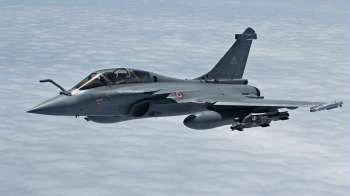On May 7, 2025, the Indian Air Force launched Operation Sindoor, a four-day air campaign in response to the Pahalgam terror attack, which had killed 26 civilians in Jammu and Kashmir just weeks earlier.
While Indian jets struck terror camps in Pakistan and Pakistan-occupied Kashmir (PoK) with precision-guided missiles, the headlines across Islamabad told a different story. Pakistan claimed it had shot down multiple Indian fighter jets, including Rafales. But new reports suggest those kills may have never happened. A recent Jane’s Defence Weekly investigation has revealed that several Pakistani claims of downing Rafales were based on successful hits on towed decoys, not actual aircraft. The deception was executed using a little-known but game-changing system onboard India’s Rafale jets, X-Guard, an artificial intelligence-powered decoy that mimics a real jet in every detectable way. What they actually hit was X-Guard, a 30-kg towed decoy system trailing invisibly behind Indian Rafales.
What is the X-Guard?
X-Guard is part of the Rafale’s SPECTRA electronic warfare suite designed for missile evasion and radar deception. Built by Rafale Advanced Defence Systems, it is a lightweight, AI-powered device deployed from the aircraft on a 100-metre fibre-optic cable. The system emits a 500-watt, 360-degree jamming signal that not only mimics the Rafale’s radar profile but also copies the Doppler shift of a moving jet. In short, to an enemy radar or heat-seeking missile, the X-Guard looks and behaves exactly like a real fighter jet. It can be deployed in under two seconds, retrieved for reuse, and adjusted in real-time to confuse both radar locks and missile seekers.
It is also capable of real-time communication with the cockpit, providing pilots with updates on decoy status, missile locks and radar engagement while remaining immune to electronic jamming.
Decoy as ‘wingman’
According to Jane’s Defence Weekly, Pakistan’s J-10C fighters equipped with KLJ-7A AESA radars and Chinese-supplied PL-15E missiles were completely thrown off. They registered radar locks and missile hits but on the decoy, not the aircraft.
Ryan Bodenheimer, a former US Air Force pilot who flew both F-15Es and F-16s, described the IAF’s use of the X-Guard as a textbook example of deception.
“It’s the best spoofing and deception we’ve ever seen,” he said. “The PL-15E couldn’t resist the spoofing. Pakistan fired on phantoms and thought they’d scored.”
The X-Guard functioned as what some experts have called a “decoy wingman”, soaking up radar attention, inviting missile fire and misleading enemy pilots, all while the real Rafales exited safely.
India rejects Pakistan’s claims
India’s Defence Secretary RK Singh, speaking to CNBC-TV18, rubbished the Pakistani claims: “You’ve used the word ‘Rafales’ in plural. That’s factually incorrect. Pakistan shot down none.”
Chief of Defence Staff General Anil Chauhan also dismissed the claims of combat losses, saying India’s forces “penetrated enemy air defences with impunity” and “executed all objectives without crossing the Line of Control.”
Inside Operation Sindoor: What actually happened?
Operation Sindoor, which ran from May 7 to 10, saw coordinated strikes by Rafales, Mirage 2000s and Su-30 MKIs using SCALP cruise missiles and Spice-2000 bombs. The operation was India’s calibrated retaliation to the Pahalgam attack, and it was executed entirely without Indian jets breaching Pakistani airspace, a deliberate move to avoid escalation. Even so, the precision of the attacks, the range of the munitions and the effectiveness of the EW tactics caught the Pakistani military by surprise.
China’s disinformation drive
In the days following Operation Sindoor, French intelligence sources told the Associated Press that China had initiated a diplomatic campaign to discredit the Rafale’s battlefield record. According to the report, Chinese embassies in Southeast Asia were tasked with briefing local defence officials on the “poor performance” of the Rafale in combat.
The goal experts believe was to undermine Dassault’s market in the region, particularly in countries like Indonesia, and to shift prospective buyers toward Chinese alternatives like the JF-17 and FC-31.
What this means for future air warfare
India’s strategic deployment of the X-Guard system has not only exposed Pakistan’s air defence vulnerabilities but has also offered the world a preview of the future of aerial combat. Rather than brute force, electronic deception, AI-powered systems and cognitive warfare are now central to air dominance.
